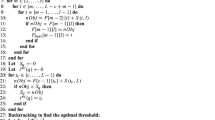Abstract
In this paper, an efficient level set model is proposed for image segmentation. Firstly, the original local binary fitting (LBF) model is redefined as a weighted energy integral, whose weight coefficient is the fast local reverse entropy of the image, and the total energy functional is then incorporated into a variational level set formulation. Secondly, the global convex segmentation method is used to construct a simplified convex segmentation model, at the same time, the edge information obtained by an edge indicator function is embedded into the total variation norm to further enhance the model’s target capture capability. Thirdly, the Split Bregman method is introduced to solve the generated convex optimization problem. Experimental results on synthetic and real images demonstrate that the proposed model has considerable improvements in terms of quantitative evaluation (being verified on the complete PASCAL VOC 2012 dataset), convergence rate, sensitivity to initial contour and robustness to noise interference compared with the state-of-the-art models. We also compare the proposed model with the famous FCN and Mask R-CNN, and make a special analysis on the adaptability of our method to occluded targets.










Similar content being viewed by others
References
Abdelsamea MM, Gnecco G, Gaber MM (2017) A SOM-based Chan-Vese model for unsupervised image segmentation. Soft Comput 21(8):2047–2067
Bregman L (1967) The relaxation method of finding the common points of convex sets and its application to the solution of problems in convex optimization. USSR Comput Math and Math Phys 7:200–217
Bresson X, Esedoglu S, Vandergheynst P, Thiran J-P, Osher S (2007) Fast global minimization of the active contour/snake model. J Math Imaging Vis 28(2):151–167
Caselles V, Kimmel R, Sapiro G (1997) Geodesic active contours. Int J Comput Vis 22(1):61–79
Chan TF, Vese LA (2001) Active contours without edges. IEEE Trans Image Process 10(2):266–277
Chan TF, Esedoglu S, Nikolova M (2006) Algorithms for finding global minimizers of image segmentation and Denoising models. SIAM J Appl Math 66(5):1632–1648
Deng H, Wei Y, Tong M (2013) Background suppression of small target image based on fast local reverse entropy operator. IET Comput Vis 7(5):405–413
Fang J, Liu H, Zhang L, Liu J, Liu H (2019) Fuzzy region-based active contours driven by weighting global and local fitting energy. IEEE Access 7:97492–97504
Goldstein T, Osher S (2009) The split Bregman method for L1 regularized problems. SIAM J Imaging Sci 2(2):323–343
Goldstein T, Bresson X, Osher S (2010) Geometric applications of the split Bregman method: segmentation and surface reconstruction. J Sci Comput 45:272–293
Guo Q, Sun S, Ren X, Dong F, Gao BZ, Feng W (2018) Frequency-tuned active contour model. Neurocomputing 275(1):2307–2316
He K, Gkioxari G, Dollar P, Girshick R (2017) Mask R-CNN. in 2017 IEEE International Conference on Computer Vision, 2980–2988.
Li Q, TingquanDeng WX (2016) Active contours driven by divergence of gradient vector flow. Signal Process 120:185–199
Li C, Kao C-Y, Gore JC, Ding Z (2007) Implicit active contours driven by local binary fitting energy. In IEEE Conference on Computer Vision and Pattern Recognition
Long J, Shelhamer E, Darrell T (2017) Fully Convolutional Networks for Semantic Segmentation. in 2015 IEEE International Conference on Computer Vision and Pattern Recognition, 3431–3440
Ronfard R (1994) Region-based strategies for active contour models. Int J Comput Vis 13(2):229–251
Vovk U, Pernus F, Likar B (2007) A review of methods for correction of intensity inhomogeneity in MRI. IEEE Trans Med Imaging 26(3):405–421
Xu C, Jerry L (1998) Prince. Snakes, shapes, and gradient vector flow. IEEE Trans Image Process 7(3):359–369
Zheng Q, Lu Z, Yang W, Zhang M, Feng Q, Chen W (2013) A robust medical image segmentation method using KL distance and local neighborhood information. Comput Biol Med 43:459–470
Zhi X-H, Shen H-B (2018) Saliency driven region-edge-based top down level set evolution reveals the asynchronous focus in image segmentation. Pattern Recogn 80(8):241–255
Zhu S, Gao R (2016) A novel generalized gradient vector flow snake model using minimal surface and component-normalized method for medical image segmentation. Biomed Signal Process Control 26:1–10
Acknowledgements
This work is supported by the Fundamental Research Funds for the Central Universities of China under Grant No. ZYGX2018J079. The authors gratefully acknowledge the financial support from China Scholarship Council (CSC) under Grant No. 201706075068. The authors would like to thank the anonymous reviewers for their valuable comments and advices.
Author information
Authors and Affiliations
Corresponding author
Additional information
Publisher’s note
Springer Nature remains neutral with regard to jurisdictional claims in published maps and institutional affiliations.
Rights and permissions
About this article
Cite this article
Wang, D. Local reverse entropy weighted LBF model solving by Split Bregman for image segmentation. Multimed Tools Appl 79, 23669–23693 (2020). https://doi.org/10.1007/s11042-020-09094-z
Received:
Revised:
Accepted:
Published:
Issue Date:
DOI: https://doi.org/10.1007/s11042-020-09094-z




